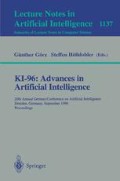Abstract
We present a novel approach to classification, based on a tight coupling of instance-based learning and a genetic algorithm. In contrast to the usual instance-based learning setting, we do not rely on (parts of) the given training set as the basis of a nearest-neighbor classifier, but we try to employ artificially generated instances as concept prototypes. The extremely hard problem of finding an appropriate set of concept prototypes is tackled by a genetic search procedure with the classification accuracy on the given training set as evaluation criterion for the genetic fitness measure. Experiments show that—due to the ability to find concise and accurate concept descriptions that contain few, but typical instances—this classification approach is considerably robust against noise, untypical training instances and irrelevant attributes.
Preview
Unable to display preview. Download preview PDF.
References
D.W. Aha and D. Kibler. Noise-tolerant instance-based learning algorithms. In Proc. 11th IJCAI, Detroit, MI, USA, pages 794–799, 1989.
D.W. Aha, D. Kibler, and M.K. Albert. Instance-based learning algorithms. Machine Learning, 6:37–66, 1991.
R. Bareiss, B. Porter, and R. Holte, Concept learning and heuristic classification in weak-theory domains. Artificial Intelligence, 45(1–2), 1990.
T.M. Cover and P.E. Hart. Nearest neighbor pattern classification. IEEE Transactions on Information Theory, 13:21–27, 1967.
P. Datta and D. Kibler. Learning prototypical concept descriptions. In A. Prieditis and S. Russell, editors, Machine Learning: Proc. of the 12th Int. Conference ICML-95. Morgan Kaufmann, San Francisco, CA, USA, 1995.
M. Fuchs and A. Abecker. Optimized nearest-neighbor classifiers using generated instances. Technical Report LSA-96-02E, University of Kaiserslautern, 1996.
G.W. Gates. The reduced nearest neighbor rule. IEEE Transactions on Information Theory, pages 431–433, May 1972.
J.H. Gennari, P. Langley, and D. Fisher. Models of incremented concept formation. Artificial Intelligence, 40:11–61, 1989.
J.H. Holland. Adaptation in natural and artificial systems: An introductory analysis with applications to biology, control, and artificial intelligence. Ann Arbor: Univ. of Michigan Press, 2nd edition, 1992.
C.Z. Janikow. A knowledge intensive genetic algorithm for supervised learning. Machine Learning, 13:198–228, 1993.
K. De Jong. Learning with genetic algorithms: An overview. Machine Learning, 3:121–138, 1988.
K.A. De Jong, W.M. Spears, and D.F. Gordon. Using genetic algorithms for concept learning. Machine Learning, 13:161–188, 1993.
J.D. Kelly and L. Davis. Hybridizing the genetic algorithm and the k nearest neighbors classification algorithm. In Proc. 4th ICGA, San Diego, CA, USA, 1991.
M. De La Maza. A prototype based symbolic concept learning system. In Proc. of the 8th Int. Workshop on Machine Learning. Morgan Kaufmann, 1991.
D.L. Medin and E.E. Smith. Concepts and concept formation. Annual Review of Psychology, (35):121–138, 1988.
D. Michie, D.J. Spiegelhalter, and C.C. Taylor. Machine Learning, Neural and Statistical Classification. Ellis Horwood, 1994.
P.M. Murphy and D.W. Aha. UCI Repository of machine learning databases [urhttp://www.ics.uci.edu/∼mlearn/MLRepository.html], Irvine, CA, University of California, Department of Information and Computer Science, 1994.
N.R. Pal, J.C. Bezdek, and E.C.-K. Tsao. Generalized clustering networks and Kohonen's self-organizing scheme. IEEE Transactions on Neural Networks, 4(4):549–557, 1993.
J.C. Schlimmer. Concept acquisition through representational adjustment. PhD thesis, University of California, Irvine, CA, 1987.
J.W. Smith, J.E. Everhart, W.C. Dickson, W.C. Knowler, and R.S Johannes. Using the ADAP learning algorithm to forecast the onset of diabetes mellitus. In Proceedings of the Symposium on Computer Applications and Medical Care. IEEE Computer Society Press, 1988.
G. Towell, J. Shavlik, and M. Noordewier. Refinement of approximate domain theories by knowledge-based artificial neural networks. In Proceedings of the 8th National Conference on Artificial Intelligence (AAAI-90), 1990.
Sh.M. Weiss and C.A. Kulikowski. Computer Systems That Learn — Classification and Prediction Methods from Statistics, Neural Nets, Machine Learning, and Expert Systems. Morgan Kaufmann, 1991.
W.H. Wolberg and O.L. Mangasarin. Multisurface method of pattern separation for medical diagnosis applied to breast cytology. In Proceedings of the National Academy of Sciences, USA, volume 87, pages 9193–9196, December 1990.
J. Zhang. Selecting typical instances in instance-based learning. In Proc. 9 th ICML, Aberdeen, Scotland, pages 470–479, 1992.
Author information
Authors and Affiliations
Editor information
Rights and permissions
Copyright information
© 1996 Springer-Verlag Berlin Heidelberg
About this paper
Cite this paper
Fuchs, M., Abecker, A. (1996). Optimized nearest-neighbor classifiers using generated instances. In: Görz, G., Hölldobler, S. (eds) KI-96: Advances in Artificial Intelligence. KI 1996. Lecture Notes in Computer Science, vol 1137. Springer, Berlin, Heidelberg. https://doi.org/10.1007/3-540-61708-6_49
Download citation
DOI: https://doi.org/10.1007/3-540-61708-6_49
Published:
Publisher Name: Springer, Berlin, Heidelberg
Print ISBN: 978-3-540-61708-2
Online ISBN: 978-3-540-70669-4
eBook Packages: Springer Book Archive

